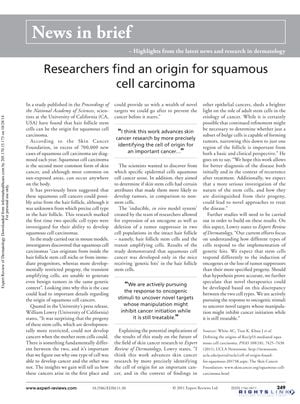News in Brief
June 2011
in “
Expert Review of Dermatology
”

TLDR Researchers discovered potential origins and new treatments for skin cancer, including biomarkers for melanoma and therapies that reduce tumor growth.
In 2011, researchers at the University of California found that hair follicle stem cells might be the origin of squamous cell carcinoma, a common skin cancer, using mouse models. This discovery could enhance the understanding of cancer development and lead to new prevention strategies. Additionally, several studies have advanced the knowledge of melanoma and skin cancer treatment. One study identified seven biomarkers that could differentiate between early-stage and metastatic melanoma, with 69% of stage IV patients showing elevated levels of at least one marker. Another study showed that targeted photodynamic therapy could effectively treat skin cancers in mice, with tumors disappearing for 100 days. A compound called ISC-4 was found to inhibit the Akt3 protein and significantly reduce melanoma lesion formation and tumor development in human skin models and mice. Whole-exome sequencing of the melanoma genome revealed genetic alterations and implicated the glutamate signaling pathway in the disease, with mutations in the GRIN2A gene found in 33% of samples and a recurrent mutation in the TRRAP gene, suggesting its role as an oncogene. These findings could inform new patient care strategies and treatments for melanoma and skin cancers. The number of participants in these studies was not provided.




